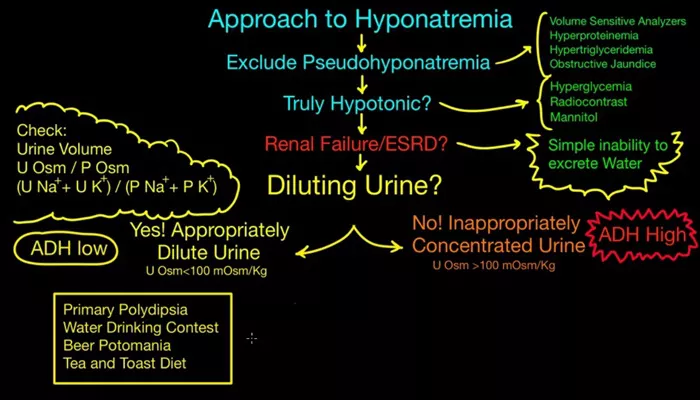Hyperlipidemia, a condition characterized by elevated levels of lipids (fats) in the blood, includes increased cholesterol and triglycerides. This condition is often linked to an increased risk of cardiovascular diseases, diabetes, and other metabolic disorders. Pseudohyponatremia, on the other hand, is a laboratory artifact where the measured serum sodium concentration is falsely low despite normal sodium levels in the body. Understanding the link between these two conditions requires delving into the physiology of lipid metabolism and the mechanisms of sodium measurement.
Mechanism of Hyperlipidemia
Hyperlipidemia arises due to an imbalance between the intake and clearance of lipids in the body. It can be primary (genetic) or secondary to lifestyle factors such as diet, obesity, and physical inactivity. High lipid levels in the blood can result from increased production, decreased clearance, or both.
Types of Lipids in the Blood
Cholesterol: A waxy substance necessary for cell membrane integrity and hormone synthesis. It is transported in the blood by lipoproteins like LDL (low-density lipoprotein) and HDL (high-density lipoprotein).
Triglycerides: The main form of fat storage in the body, derived from the diet and synthesized in the liver. Elevated triglyceride levels are particularly associated with cardiovascular risk.
SEE ALSO: When to Start Drug Therapy for Hyperlipidemia
Pathogenesis of Hyperlipidemia
Dietary Intake: Consumption of high-fat diets, particularly those rich in saturated and trans fats, can elevate blood lipid levels.
Genetic Factors: Genetic disorders like familial hypercholesterolemia can lead to high cholesterol levels from birth.
Metabolic Disorders: Conditions such as diabetes and hypothyroidism can impair lipid metabolism, contributing to hyperlipidemia.
Sodium Homeostasis in The Body
Sodium is a crucial electrolyte involved in maintaining fluid balance, nerve function, and muscle contractions. The body tightly regulates sodium levels through mechanisms involving the kidneys, hormones, and cellular transport.
Role of Sodium in The Body
Fluid Balance: Sodium helps regulate the extracellular fluid volume, impacting blood pressure and overall hydration status.
Nerve and Muscle Function: Sodium ions are essential for action potentials, which enable nerve transmission and muscle contractions.
Regulation of Sodium Levels
Kidneys: Filter and reabsorb sodium based on the body’s needs.
Hormones: Aldosterone and antidiuretic hormone (ADH) play pivotal roles in sodium and water reabsorption.
Transport Mechanisms: Sodium-potassium pumps and other transporters help maintain the balance of sodium across cell membranes.
Pseudohyponatremia: A Laboratory Artifact
Pseudohyponatremia occurs when the measured sodium concentration in the blood serum is falsely low, despite normal sodium levels in the body. This discrepancy arises due to the presence of high concentrations of lipids or proteins in the blood, which interfere with the measurement methods.
Causes of Pseudohyponatremia
Hyperlipidemia: Elevated levels of lipids, particularly triglycerides, can lead to pseudohyponatremia.
Hyperproteinemia: High levels of proteins, such as in multiple myeloma, can also cause this artifact.
Measurement Methods And Errors
Indirect Ion-Selective Electrode (ISE) Method: Most commonly used in clinical laboratories, this method can be affected by the presence of lipids and proteins, leading to falsely low sodium readings.
Direct Ion-Selective Electrode (ISE) Method: Less commonly used but more accurate in cases of hyperlipidemia, as it measures sodium directly in the plasma water fraction, avoiding the interference from lipids.
How Hyperlipidemia Causes Pseudohyponatremia
Hyperlipidemia leads to pseudohyponatremia through a dilutional effect in the blood sample. When blood serum contains high levels of lipids, the aqueous phase, where sodium is dissolved, is reduced in volume. This reduction leads to an underestimation of the sodium concentration when measured by indirect methods.
Dilutional Effect of Lipids
Serum Composition: Blood serum consists of an aqueous phase and a lipid phase. In hyperlipidemia, the lipid phase is disproportionately increased.
Measurement Error: Indirect ISE methods assume a standard ratio of lipid to aqueous phases. When this ratio is altered by hyperlipidemia, the sodium concentration appears lower than it truly is in the aqueous phase.
Clinical Implications
Misdiagnosis: Pseudohyponatremia can lead to misdiagnosis and unnecessary treatments if not properly identified.
Accurate Measurement: Direct ISE methods should be used for accurate sodium measurement in patients with hyperlipidemia to avoid diagnostic errors.
Clinical Management And Diagnosis
Proper diagnosis and management of pseudohyponatremia require awareness of the patient’s lipid profile and the appropriate use of laboratory techniques.
Identifying Pseudohyponatremia
Lipid Profile Assessment: Measuring serum lipid levels in patients with hyponatremia can help identify pseudohyponatremia.
Use of Direct ISE Method: When hyperlipidemia is suspected, using direct ISE methods for sodium measurement is crucial for accurate diagnosis.
Managing Hyperlipidemia
Lifestyle Modifications: Diet and exercise are fundamental in managing hyperlipidemia. Reducing intake of saturated and trans fats, increasing physical activity, and weight management can lower lipid levels.
Medications: Statins, fibrates, and other lipid-lowering agents can be prescribed to manage hyperlipidemia effectively.
Monitoring And Follow-Up
Regular Lipid and Sodium Monitoring: Patients with hyperlipidemia should have regular lipid profiles and sodium levels checked to monitor their condition and prevent complications.
Adjusting Treatment Plans: Based on lipid and sodium levels, treatment plans should be adjusted to ensure optimal patient outcomes.
Conclusion
Understanding the link between hyperlipidemia and pseudohyponatremia is essential for accurate diagnosis and effective management of patients. Hyperlipidemia, by increasing the lipid content in blood serum, can lead to falsely low sodium readings, a condition known as pseudohyponatremia. Recognizing this laboratory artifact and employing accurate measurement techniques are crucial steps in preventing misdiagnosis and ensuring appropriate patient care. Through lifestyle modifications, medication, and regular monitoring, hyperlipidemia can be effectively managed, thereby minimizing the risk of pseudohyponatremia and its associated complications.

